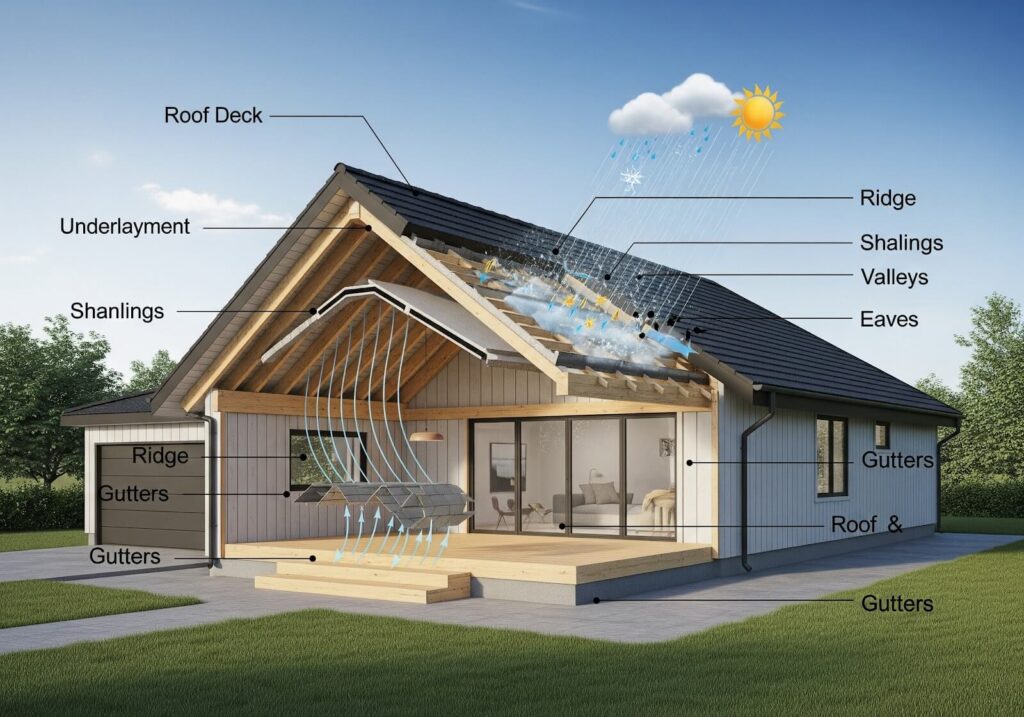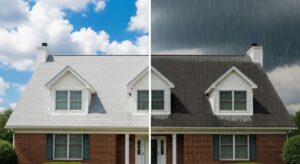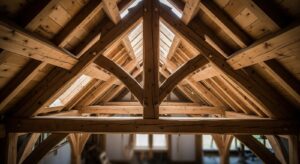Most people only think about their roof when it starts leaking. But knowing the parts of a roof helps you spot small problems before they turn costly, communicate clearly with contractors, and protect your biggest investment—your home. Think of this guide as your “roof anatomy diagram” explained in plain English.
What Is a Roof?

A roof is more than just the shingles you see from the street. At its core, it’s a carefully designed structure of a roof that shields your home from rain, snow, wind, heat, and even wandering critters.
Every residential roof construction includes layers that work together like a team. The roof deck forms the base, much like skin stretched over a skeleton. The underlayment acts as a waterproof jacket. The shingles or covering are the outer armor, while hidden details like flashing, soffits, and fascia handle ventilation and water management.
When people ask, “What supports the roof of a house?” the answer is the beams of the roof that go across (rafters or trusses). These are the backbone of the system.
By the end of this guide, you’ll be able to identify the names of roof components, understand their jobs, and even look at a roof diagram with confidence.
Why Knowing Roof Parts Matters

Imagine taking your car to a mechanic and only being able to say, “It makes a funny noise.” You’d feel powerless, right? The same goes for your roof. Understanding the parts of a house roof gives you:
- Clearer communication with contractors. Instead of pointing vaguely and saying, “That side of the roof,” you can confidently say, “The shingles in the valley are lifting.” That not only earns respect but also ensures you’re talking about the same thing.
- Better maintenance and early detection. If you know what the eaves or flashing do, you’ll be more likely to spot issues like water stains, loose gutters, or poor ventilation before they snowball into expensive repairs.
- Smarter decision-making. Whether you’re considering replacing shingles, upgrading to metal, or debating repair vs. replacement, knowing the roof elements helps you weigh options wisely.
In short, a little roof knowledge is like learning basic first aid: you might not do the surgery yourself, but you’ll know when to call a professional.
Main Parts of a Roof
Here’s where we break down the roof construction components piece by piece.
1. Roof Deck
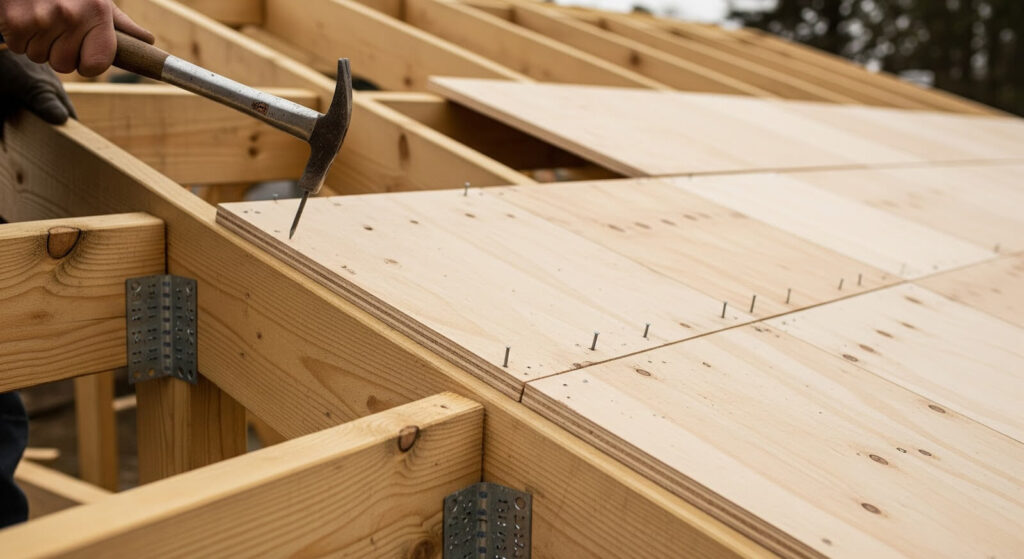
The roof deck is the foundation of the entire system—the flat surface nailed to the rafters or trusses. Think of it as the stage on which all other roof elements perform.
Common materials:
- Plywood (most common in modern residential roof construction)
- Oriented Strand Board (OSB)
- Older homes may still have plank decking
Without a solid deck, the rest of the roof is just a flimsy costume.
2. Underlayment
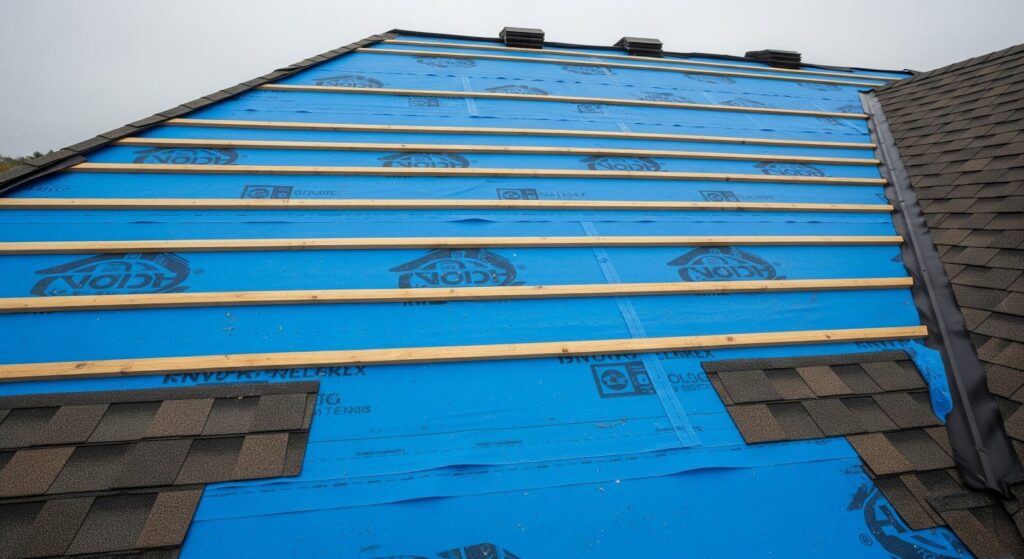
Directly above the deck lies the underlayment—a thin layer that acts like your roof’s raincoat. Even if shingles blow off in a storm, the underlayment provides temporary protection.
Types:
- Felt (tar paper): Traditional, affordable, but less durable.
- Synthetic underlayment: Stronger, lighter, and more resistant to tearing.
- Ice and water shield: A sticky membrane placed in vulnerable areas like valleys.
3. Shingles or Roof Covering
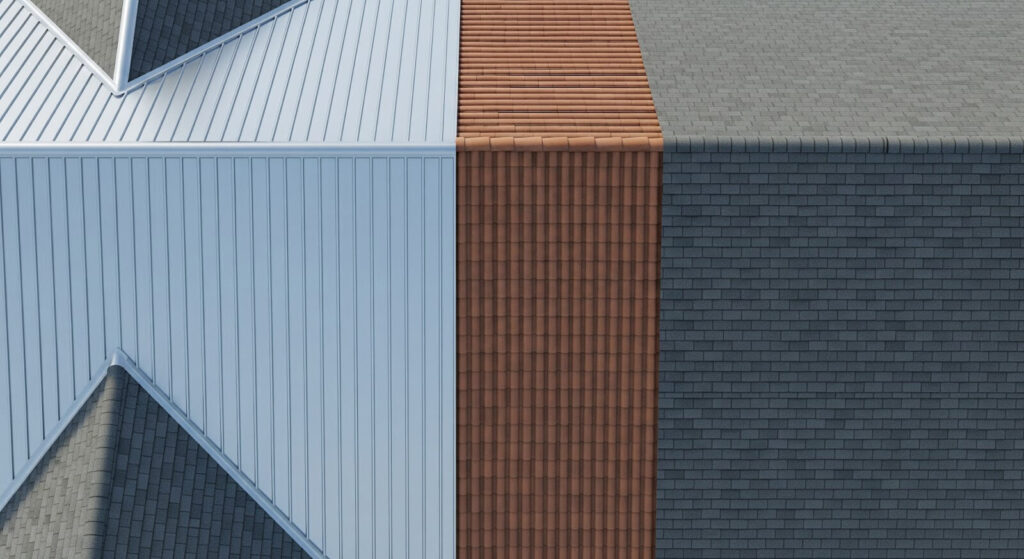
The shingles are what you see and what most people think of when they picture a roof diagram. They’re the main weather barrier.
Popular options:
- Asphalt shingles: Affordable and common, lasting 15–30 years.
- Metal roofing: Durable, stylish, and energy-efficient.
- Clay or concrete tile: Long-lasting but heavy.
- Slate: Elegant but pricey and requires strong roof structure components.
4. Ridge
The ridge is the top horizontal line where two sloping sides meet. If someone asks, “What is the top of a roof called?”—this is it.
It often includes ridge vents to allow hot attic air to escape.
5. Hip
A hip is similar to a ridge, but it’s found where two roof planes meet at an outward angle (like the corner of a pyramid roof). It adds stability and directs water off the sides of the roof.
6. Valleys
Valleys are the inward angles where two slopes meet. They act like gutters built into the roof, channeling water toward the gutters and downspouts. Because they handle so much water flow, valleys are one of the most leak-prone parts.
7. Eaves
Eaves are the overhanging edges that extend past your walls. They keep rain from running directly down siding and soaking your foundation. Picture them as your home’s umbrella edges.
8. Fascia
The fascia board sits at the edge of the eaves, directly behind the gutters. It gives the roof a finished look and provides a place to attach the gutter system. Without sturdy fascia, gutters sag or detach.
9. Soffit
Located beneath the eaves, the soffit often has small vents that let fresh air into the attic. This prevents heat and moisture buildup that could warp your roof frame. Think of soffits as the “lungs” of your home’s ventilation system.
10. Flashing
Flashing is thin metal installed around chimneys, skylights, and valleys—anywhere water might sneak in. It’s the unsung hero of roof construction components, preventing leaks at joints.
Materials include: aluminum, galvanized steel, or even copper for premium roofs.
11. Gutters & Downspouts
Though some debate whether gutters are truly “part of a roof system,” they’re crucial for water management. Gutters collect runoff, and downspouts carry it away from your foundation.
Routine cleaning is essential—roof storm damage assessment often reveals clogged gutters as a root cause of water intrusion.
How to Identify Roof Parts on Your Home
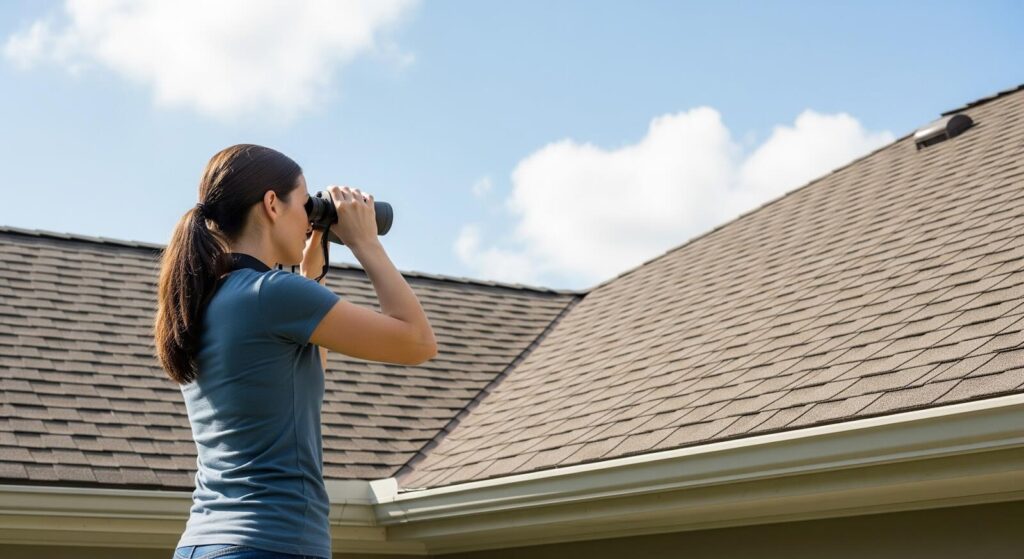
Spotting house roof components doesn’t require climbing a ladder.
- From the ground: You can see shingles, ridges, hips, valleys, gutters, fascia, and sometimes soffits.
- With binoculars: A safer way to check flashing or spot curled shingles.
- Inside the attic: Look for ventilation, daylight cracks, or signs of a weakened roof deck.
Safety tip: Avoid climbing unless you’re trained and have proper gear. Falls are the #1 cause of homeowner injuries during roof inspection.
If you notice something unusual—like sagging, water stains, or missing shingles—it’s time to call a professional roofer for a closer inspection.
Common Roof Problems by Part
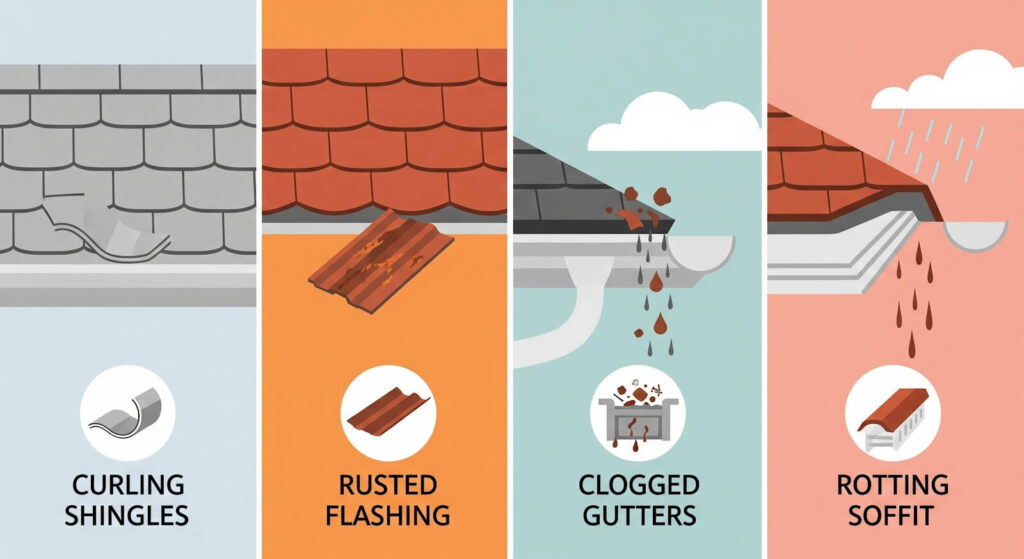
Shingles
- Curling or cracking from heat and age
- Missing pieces after storms
- Granule loss that exposes the base
Valleys
- Debris buildup blocking water flow
- Rusted or damaged valley flashing leading to leaks
Flashing
- Rust, holes, or detachment
- Poor installation around chimneys or skylights
Gutters
- Clogged with leaves, causing water overflow
- Pulling away from fascia due to weight
Soffit & Fascia
- Rot from trapped moisture
- Holes allowing pests into the attic
How to Maintain Different Roof Parts
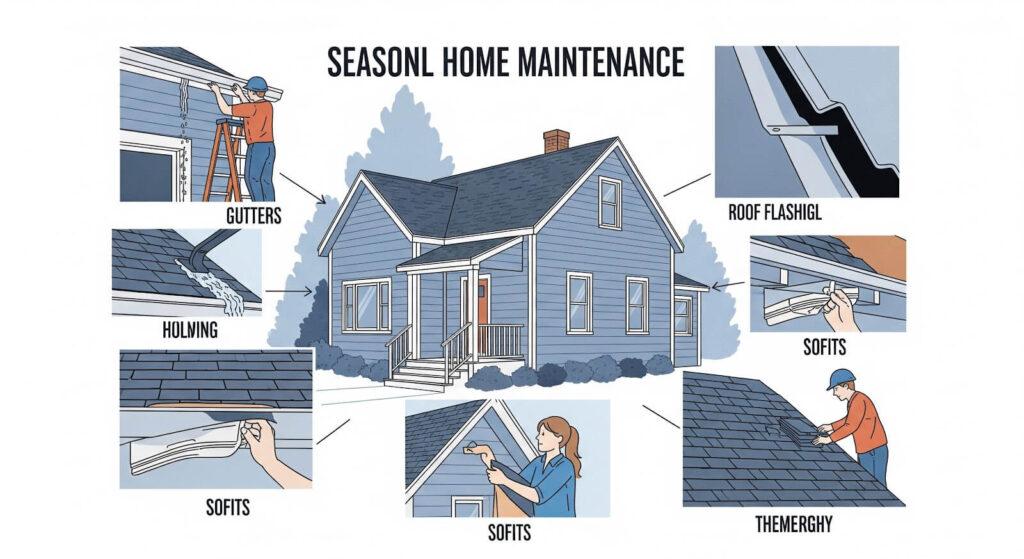
- Clean gutters regularly. At least twice a year, more if trees hang overhead.
- Check flashing after storms. Look for loose or bent metal.
- Monitor attic ventilation via soffits. Poor airflow means condensation and mold.
- Replace damaged shingles quickly. A single missing shingle can cause a chain reaction.
- Schedule professional inspections every 1–2 years. Roofers can spot hidden issues before they become disasters.
When to Call a Roofing Professional
DIY checks are fine for small things, but some situations demand a pro:
- Persistent leaks, even after quick fixes
- Sagging or signs of structural damage in the roof frame
- Large areas of missing shingles
- Storm damage assessment (especially if insurance is involved)
Roofers bring not only safety equipment but also years of trained eyes. Delaying repairs can turn a $300 fix into a $3,000 replacement. When in doubt, make the call—it’s cheaper than ignoring the problem.
Frequently Asked Questions
Q: What is the most important part of a roof?
A: Hard to pick one—shingles protect, flashing waterproofs, and ventilation keeps everything healthy. But without a solid roof deck, nothing else works.
Q: How long do shingles usually last?
A: Asphalt lasts 15–30 years, metal 40–70, slate or tile 50+. Climate, installation, and maintenance play big roles.
Q: Can I replace flashing myself?
A: Small patches, maybe. But full replacements are tricky. Bad flashing is one of the top causes of roof leaks. Best left to pros.
Q: What roof part is most prone to leaks?
A: Valleys and flashing around chimneys/skylights. Anywhere water naturally gathers or changes direction.
Q: Do gutters count as part of the roof?
A: They’re technically an accessory, but since they handle runoff, most roofers consider them part of the roof system.
Q: What’s the difference between fascia and soffit?
A: Fascia is the vertical board behind gutters; soffit is the underside of the overhang. Together they protect and ventilate.
Q: How often should I inspect my roof?
A: Twice a year—spring and fall. Add extra checks after big storms.
Q: What’s the cheapest roof material?
A: Asphalt shingles are the most budget-friendly, especially in standard residential roof structure designs.
Q: Do roof parts vary by climate or region?
A: Yes—snowy regions need ice shields, hot climates prefer reflective roofing, and hurricane zones require reinforced roof construction.
Q: How do I know if my roof deck is damaged?
A: Look for sagging, spongy spots when walked on, or water stains in the attic. Professional inspection is usually required for confirmation.
Final Thoughts
The roof is more than just a lid on your house—it’s a carefully engineered system. By understanding the parts of a roof structure—from the ridge down to the gutters—you’ll not only protect your home but also speak the same language as roofing pros.

